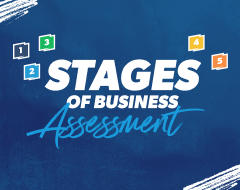7 Keys to Developing Leaders in Your Small Business
5 Min Read | Jan 22, 2025

You’ve worked hard to get your business off the ground. And now that your business and your team are growing, you need to invest some time in developing leaders who can help you keep it moving forward.
Folks who reach this point are usually in what we call the Trailblazer stage of business. You’re no longer just working to make payroll. You’re scaling your team and your skills and building momentum. New opportunities are coming at you fast and furiously—almost faster than you can handle. Without a plan for developing new leaders, you’re in danger of being stretched too thin to manage that growth and continue scaling your business.
The good news is you can build your leadership bench from the all-stars already on your team. When you do, your whole business wins:
- You build your leadership team with people you already share your values and work ethic. (That means you also avoid recruiting candidates who may not be the right fit for your mission and culture.)
- You reduce hiring and onboarding costs because you’re promoting from within.
- You give your team members a clear path to advance, increasing job satisfaction and loyalty to your company.
Before you know it, you’ll graduate to the next stage of business, Peak Performer. But before we get ahead of ourselves, let’s focus on our first order of business—building leaders.
Ready to Level Up Your Business?
Find out your Stage of Business with our free assessment and get additional resources to help you level up by focusing on the right things at the right time.
How to Develop Leaders in Your Organization
Even with all its benefits, let’s be honest: Building leaders sometimes feels way harder than doing everything yourself. Is it easy to carve out the time? No. Will you feel perfectly equipped to do it at first? Probably not. But you’ll feel more prepared and save time in the long run when you follow these keys to developing new leaders:
1. Get a working definition of leadership.
Ask 10 different people how they define leadership, and you’ll get 10 different answers. But that won’t work when you’re building a leadership culture. You and your key team members have to agree on what a leader in your organization looks like so you’re aligned on how to identify, promote and train emerging leaders.
Related article: What Is Leadership?
2. Commit to creating a strong leadership culture.
In baseball, you build your bench with talented relief pitchers, backup infielders and outfielders, plus utility players you can put in the game at a moment’s notice. The same is true for your business when you’re building a strong leadership culture. You routinely and systematically raise up unified, all-star team members who are ready to lead meetings, projects or whole teams of other rising stars. Commit to creating that kind of culture so your team sees you’re serious about growth and long-term success for them as well as your business.
Related article: What Is Company Culture?
3. Make a strategic plan.
Next, you’re ready to reimagine your organizational chart and decide which leadership gaps you want to fill first. Do you need a creative director bringing brand consistency among your writers and designers? A sales director keeping your account executives on target? Or maybe an assistant sales director learning to manage people and not just accounts? Decide what leaders you want so you can start working on a strategy to get them in place.
Related article: Your Guide to Strategic Planning That Boosts Your Business
4. Identify potential leaders.
Now comes the really fun part. Identify your most hungry, humble and smart team members and the growth path you see for them. Who’s eager to tackle challenges, confident but not arrogant, and great at working with others? Plug them into the strategic plan you developed. If you have more leadership roles than people ready to grow into them, now’s the time to look outside your organization for the additional leaders you need.
Pro tip: Don’t just look at how much output a potential leader produces. Yes, your leaders should know how to get results, but they also need to think critically, work well with others and lead with vision.
5. Mentor rising leaders.
Leadership is caught more than taught. Spend time with the leaders you’re developing. Show them how you make decisions and solve problems—and challenge them to think critically instead of just taking orders. You can also delegate nonfatal decisions and tasks so your growing leaders have room to fail and learn from their mistakes. Use your one-on-one meetings to set expectations, give direction, allow time for questions, and give feedback to help your team members level up.
Remember, mentors aren’t bosses demanding things be done their way. They’re teachers. They’re also champions of their team members’ strengths and goals. When you help them succeed, you’ll succeed too.
Pro tip: When a team member brings you a question, don’t just answer. Ask why they’re bringing it to you. Do they think you need to approve their next steps, want your advice, or need a sounding board? When you’re clear on their motive, you’ll see where they are in their development and give a better response. You may even choose to fully empower them to make decisions without you if they’re ready.
6. Communicate—a lot.
While your one-on-one meetings are a prime opportunity to teach and champion your growing leaders, quick conversations during or after meetings where you share your thoughts in the moment can be even more helpful. It just takes a minute to talk through why you handled an issue a certain way, get their thoughts, or challenge them.
Related article: How to Communicate Effectively
7. Model servant leadership.
You can always count on this truth: If you’re a leader, people are watching you. They want to see how you do things, but they also want to know you’re trustworthy. Your team members aren’t looking for you to know everything or do everything perfectly. But they are looking at how you live out your values and treat others. (Remember, more is caught than taught.)
Related article: What Is Servant Leadership?
Next Step: Buckle Up and Build Leaders
- Check out the seven signs it’s time to build leaders.
- Get clear on which stage of business you’re in by taking the EntreLeadership Stages of Business Assessment.
- If you're at stage 3 or beyond, apply what you've learned in this article so that you're no longer the only leader making decisions.

